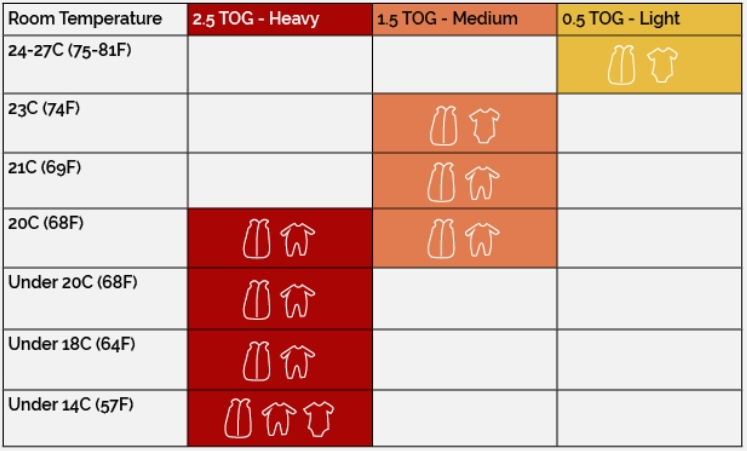READY FOR A BETTER SLEEP?
Big Tips For Littlies Sleep
At Bubbaroo, we’ve got you covered throughout bubs early sleep journey. Newborn bubs start with our Joey Pouch® to wrap them up for better quality sleep. Once baby is rolling onto their tummy, it’s time to transition to the Joey Pod Transitional Swaddle Bag or directly into a Joey Swag® Baby Sleeping Bag which is specially designed for baby to move freely while staying covered. Our four Swag sizes will take bub from Newborn to 6 years. A little Bubbaroo goes a long way toward better sleep.
DRESSING GUIDE
WHY SWADDLE
• Sleep baby on back from birth, not on tummy or side
• Sleep baby with head and face uncovered
• Keep baby smoke free before birth and after
• Provide a safe sleeping environment day and night
• Sleep baby in their own safe sleeping place in the same room as an adult care-giver for the first six to twelve months of life
• Breastfeed baby
For further information regarding the safe sleeping recommendations please refer to www.rednose.com.au
We have compiled the below video on setting up a safe sleep environment for your baby below.
BUBBAROO DRESSING GUIDE
PLATINUM JOEY SWAGS IN 3 DIFFERENT WEIGHTS OR WARMTH RATINGS (TOGS)
2.5 TOG All year round - Ideal for Autumn, Winter and cooler Spring days for rooms of 10-20°C (50-68°F)
1.5 TOG Summer and daytime naps - Versatile - for warmer weather and in rooms of 20-23°C (69-74°F)
0.5 TOG Summer - Hot weather and very warm rooms of 24-27°C (75-81°F)
The table below provides a guide to what TOG/weight Joey Swag® can be used and suggestions of the clothing baby can wear with their Joey Swag®. Once asleep, check baby's temperature by placing a hand on baby's chest to ensure baby is comfortably warm and not too hot.

Joey Pouch Swaddle Wrap
| Room Temperatures | Clothing | Additional Bedding |
|---|---|---|
28°C+ (82.4°F+) |
Singlet or just a nappy | No additional bedding |
26-28°C (78.8-82.4°F) |
Singlet | No additional bedding |
24-26˚C (75.2-78.8°F) |
Short sleeved body suit or Short sleeved pyjama top | No additional bedding |
22-24˚C (71.6-75.2°F) |
Short sleeved body suit & singlet | No additional bedding |
|
20°C - 22 (68-71.6°F) |
Long sleeved body suit & singlet | No additional bedding |
18 -20°C (64.4-68°F) |
Long sleeved romper or Long sleeved pyjamas | Bubbaroo® Blankie |
16 -18°C (60.8-64.4°F) |
Long sleeved romper & singlet or Long sleeved pyjamas & singlet | Bubbaroo® Blankie |
Joey Pod Transitional Swaddle Bag
| Room Temperatures | Clothing - Swaddled | Additional Bedding | Clothing - baby sleeping bag(both arms out) |
|---|---|---|---|
|
28°C+ (82.4°F+) |
Singlet or just a nappy | No additional bedding | Singlet or just a nappy |
|
26-28°C (78.8-82.4°F) |
Singlet | No additional bedding | Short sleeved body suit or Short pyjamas |
|
24-26˚C (75.2-78.8°F) |
Short sleeved body suit or Short sleeved pyjama top | No additional bedding | Short sleeved body suit & singlet |
|
22-24˚C (71.6-75.2°F) |
Short sleeved body suit & singlet | No additional bedding | Long sleeved body suit & singlet |
|
20°C - 22 (68-71.6°F) |
Long sleeved body suit & singlet | No additional bedding | Onesie & singlet or Long sleeved pyjamas & singlet |
|
18 -20°C (64.4-68°F) |
Long sleeved romper or Long sleeved pyjamas | Bubbaroo® Blankie | Onesie & long sleeved body suit or Long sleeved pyjama & long sleeved body suit |
|
16 -18°C (60.8-64.4°F) |
Long sleeved romper & singlet or Long sleeved pyjamas & singlet | Bubbaroo® Blankie | Onesie & long sleeved body suit & singlet or Long sleeved pyjama & long sleeved body suit & singlet |









